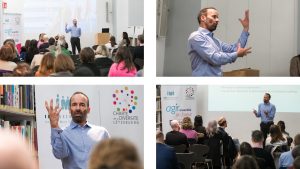The Diversity Dilemma: Global coherence versus local relevance
Diversity seems to naturally focus on differences and separation can intensify when adding an international and hence intercultural dimension. Global corporations, on the other hand, require consistency across their organisations and also need D&I approaches that are universally applicable. An expert event discussed the related dilemma.
What if we could find a way to bring Diversity together, find a coherent approach and make it easier for people to grasp the concept and its opportunities – across locations? And what if we could do this while acknowledging and addressing specific needs and be mindful of local contexts and underlying values?
Resolving the riddle of complexities
What sounds like a miracle agenda may not be easily implemented. Yet, looking at both the long-term and the international development of D&I help us to see overlap. This advanced expert question was in the focus of an IMS Luxembourg event that examined how to strike the balance of global consistency and local limitations or needs. The European D&I Engineer, Michael Stuber, provided an overview of facts, a comparison of different approaches and a consolidation of key recommendations.
Focus on Difference – boon and bane of diversity
When we explore the universe of Diversity, we consider race, gender, different abilities, ages, faiths/beliefs or sexual orientations, identities or expressions. In many ways and contexts, this has created enough complexity for people and many prefer to work on one topic at a time and admit intersectionality when it’s necessary.
When in Rome, do as the Romans do
As soon as we cross cultural borders, though, our instinct tells us that things change and that, e.g., the relevance of gender, age or religion and related dynamics will be different in other cultures. This perception may have been built into D&I at the outset when its formation narrative was linked to US civic action. Subsequently, D&I was reconsidered and redesigned for other world regions and local, cultural conflict seemed to confirm that cultural differences have a decisive changing impact on D&I.
LGBTQI as a (test) Case for Diversity
Since these early Diversity days, the question of whether and how to raise LGBTQI topics in a certain environment has probably been most emblematic in illustrating possible local or intra-diversity conflicts. In the beginning – unlike heterosexual orientation – LGBT topics were labelled ‘private’ and hence banned from the workplace. They were also banned from larger diversity frameworks due to religious issues (not just Muslim). It took decades to overcome most of these barriers when from 2016, Donald Trump challenged LGBTQI freedom and equality. In the aftermath of this new backlash, LGBT was labelled ‘political’ by FIFA and UEFA officials.
These are examples why LGBTQI has always served as a test case for the credibility of a D&I concept. They examples also serve as explanations why LGBTQI continues to be the most fragile core dimension of Diversity (along with religion/belief) and an indicator for the integration and comprehensiveness – and eventually coherence and consistency – of its framework.
Corporate Coherence made easy
In the first part of his key-note, Stuber showed the current – and historic – differences between different diversity dimensions including in Corporate Reporting. He explained how corporate values and a consistent business case connect differences and inclusiveness with the company framework. A regional focus (e.g. Europe or Asia or North America) eases both understanding, buy-in and implementation.
With regard to the topical focus of the event, Michael gave many examples of how companies can include LGBTQI in their global frameworks and support all employees everywhere.

